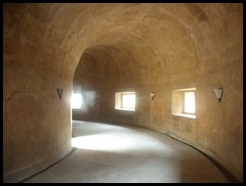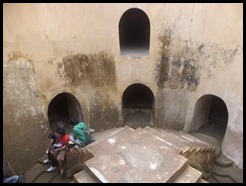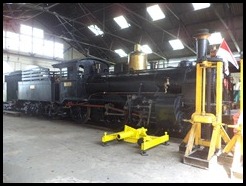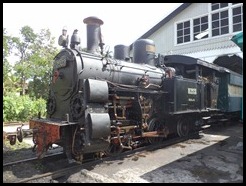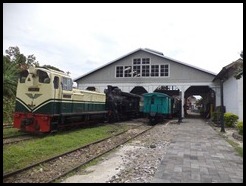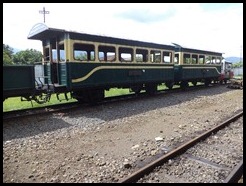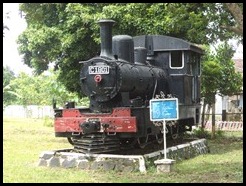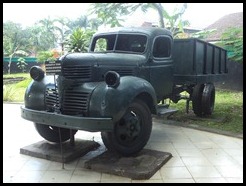I went to the Prambanan Temple site again, not to see the main site but to have another look at the Sewu Temple which is mainly a large collection of ruins, piled up stones and which I found to be more interesting than the rebuilt main site. Oddly enough I spoke to Korean/American and Indonesian women who preferred this site to the main one as well. Again I was the only person on the site as it seems that most people do not want to walk the 2 kilometres there or even get off a little road train that continually drives around the site.
The temple was probably built in 8th century and was possibly the centre of religious activities of Buddhist people. Sewu Temple, (the second biggest Buddhist temple after Borobudur, and Prambanan temple), which is a Hindu temple, indicated that Hindu and Buddhist communities had lived together without ant problems. The name “Sewu” (from the Javanese word, meaning thousand) indicates that there are many shrines included in the Sewu Temple compound, although their number does not reach a thousand. Sewu Temple has 249 shrines consisting of 1 main central temple, 8 flanking or intermediate shrines, and 240 ancillary shrines in a symmetrical arrangement. Sewu Temple has four gates and each of them is guarded by a couple of Dwarapala statues facing each other. From the outer court into the inner court, there are also four gates, each guarded by a couple of Dwarapala statues similar to those at the outer gates. Each of the Dwarapala statues is made of a single block of stone, placed on a square base 1.2 metres high with one leg on its knee, the other one bended, and one hand holding a club. The statue stands 2.3 metres high and is fantastic to see.
Having been told that there was another temple near-by (3 kilometres away) I went and visited the Plaosan Temple, again more of a collection of ruins and stones but still fascinating. The complex is divided into two groups, namely the North Plaosan Temple and the South Plaosan Temple. Both of the temples have square terrace that is encircled by wall, a pillbox for meditation at the west part and dome on other side. Because of that similarity, the appearance of both temples are the same when they are seen from distant so that Plaosan temple is also called the twin temples.The entire complex has 116 ancillary domes and 50 ancillary temples. Ancillary domes can be seen on each side of the main temple, as can smaller ancillary temples.
The palace of Jogyakarta is known as the Kreton or Sultan's Palace and which I visited on another day. It is a complex that reflects the Javanese culture and architecture. It was designed and built in stages and completed in 1790.
This complex of pavilions was constructed entirely on ancient beliefs and each feature of the complex, from the courtyards to the trees, has a special symbolic meaning related to sophisticated Javanese world view. The Keraton was built facing directly north towards Mount Merapi. Malioboro Road (the main shopping street in Jogyakarta) was originally used as the ceremonial route, not unlike London’s Pall Mall, and forms a straight line drawn from the Sultan’s palace to the Merapi volcano. The palace was designed to be more than just a royal residence but as a focal point of the Sultan’s entire kingdom. Today, the Kraton (Palace) is a piece of living history and tradition. It continues to be used, both as a home of the Sultan as well as for other important ceremonial and cultural functions of the Yogya court. The present Sultan Hamengku Buwono X of Jogyakarta retains the title of Sultan although Yogya (the local name for Jogyakarta has become one of the provinces of the Republic of Indonesia. The Sultan of Yogya,is also the governor of the province, and is still considered the cultural head of this region, and is greatly loved by the people. There are actually two parts in the palace that can be visited, the first being the terrace area then, if the staff remember to tell anyone how to get to it, the palace area behind with an entrance a few hundred metres further along the road.
In the back streets is the Taman Sari Water Castle, an old photograph of which is shown below. It looks very much the same now except that the area round the castle has been built on. This is the site of a former royal garden of the Sultanate of Yogyakarta being built in the mid-18th century. Only the central bathing complex has been preserved, while the other areas have been largely built over. The complex consists of about 59 buildings including a mosque, meditation chambers, swimming pools, and a series of 18 water gardens and pavilions surrounded by artificial lakes. The complex was used between 1765–1812.
The Water Castle was a bathing complex for the royal family and consists of three pools decorated with mushroom-shaped springs and large flower pots. There are two buildings in the bathing complex. The northernmost building was used as the resting place and changing room for the daughters and concubines of the sultan. On the south side of this building is a pool known as Umbul Muncar which is divided into two by a central pathway. The next building on the south is a building with a tower in its centre. The right wing of the building was used as the sultan's changing room, the east wing was used as his resting place. The central tower was used by the sultan to observe his daughters and concubines bathing in the pool. On the south of this building is the third pool that was used only by the sultan and his concubines. During its era, only females and the sultan were allowed to enter this bathing complex.
Photographs of the underground mosque near the castle
Street Scenes
The temple was probably built in 8th century and was possibly the centre of religious activities of Buddhist people. Sewu Temple, (the second biggest Buddhist temple after Borobudur, and Prambanan temple), which is a Hindu temple, indicated that Hindu and Buddhist communities had lived together without ant problems. The name “Sewu” (from the Javanese word, meaning thousand) indicates that there are many shrines included in the Sewu Temple compound, although their number does not reach a thousand. Sewu Temple has 249 shrines consisting of 1 main central temple, 8 flanking or intermediate shrines, and 240 ancillary shrines in a symmetrical arrangement. Sewu Temple has four gates and each of them is guarded by a couple of Dwarapala statues facing each other. From the outer court into the inner court, there are also four gates, each guarded by a couple of Dwarapala statues similar to those at the outer gates. Each of the Dwarapala statues is made of a single block of stone, placed on a square base 1.2 metres high with one leg on its knee, the other one bended, and one hand holding a club. The statue stands 2.3 metres high and is fantastic to see.
 |
| Showing the elaborate carving |
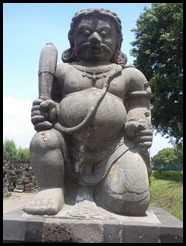 |
| Dwarapala Statue |
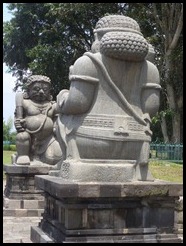 |
| A pair of Dwarapala Statues at one of the gates |
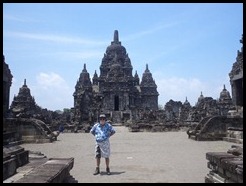 |
| Me as the tourist wearing a covering which had to be worn out of respect to the meaning of the temple |
 |
| Site Views |
 |
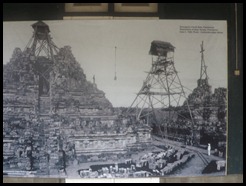 |
| The rebuilding of Sewu Temple |
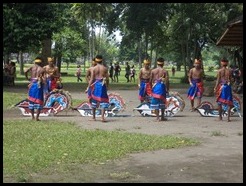 |
| Local dancers in the temple grounds |
 |
| Pooh Bear in Indonesia |
 |
| Prambanan Temple at night |
Having been told that there was another temple near-by (3 kilometres away) I went and visited the Plaosan Temple, again more of a collection of ruins and stones but still fascinating. The complex is divided into two groups, namely the North Plaosan Temple and the South Plaosan Temple. Both of the temples have square terrace that is encircled by wall, a pillbox for meditation at the west part and dome on other side. Because of that similarity, the appearance of both temples are the same when they are seen from distant so that Plaosan temple is also called the twin temples.The entire complex has 116 ancillary domes and 50 ancillary temples. Ancillary domes can be seen on each side of the main temple, as can smaller ancillary temples.
 |
| Plaosan Temple |
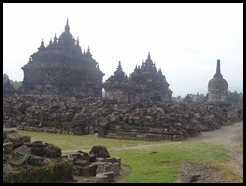 |
| Plaosan Temple |
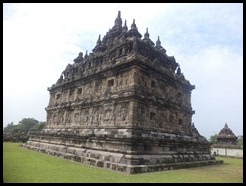 |
| Plaosan Temple |
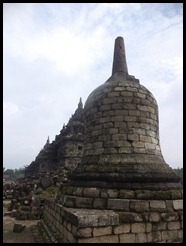 |
| Plaosan Temple |
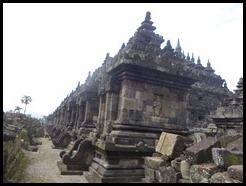 |
| Plaosan Temple |
This complex of pavilions was constructed entirely on ancient beliefs and each feature of the complex, from the courtyards to the trees, has a special symbolic meaning related to sophisticated Javanese world view. The Keraton was built facing directly north towards Mount Merapi. Malioboro Road (the main shopping street in Jogyakarta) was originally used as the ceremonial route, not unlike London’s Pall Mall, and forms a straight line drawn from the Sultan’s palace to the Merapi volcano. The palace was designed to be more than just a royal residence but as a focal point of the Sultan’s entire kingdom. Today, the Kraton (Palace) is a piece of living history and tradition. It continues to be used, both as a home of the Sultan as well as for other important ceremonial and cultural functions of the Yogya court. The present Sultan Hamengku Buwono X of Jogyakarta retains the title of Sultan although Yogya (the local name for Jogyakarta has become one of the provinces of the Republic of Indonesia. The Sultan of Yogya,is also the governor of the province, and is still considered the cultural head of this region, and is greatly loved by the people. There are actually two parts in the palace that can be visited, the first being the terrace area then, if the staff remember to tell anyone how to get to it, the palace area behind with an entrance a few hundred metres further along the road.
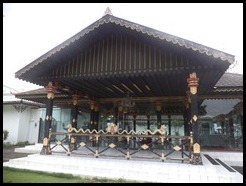 |
| Audience Hall |
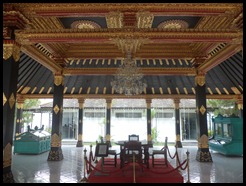 |
| Inside the Audience Hall |
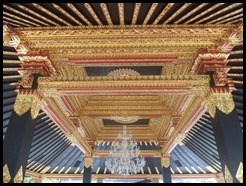 |
| Ceiling of the Audience Hall |
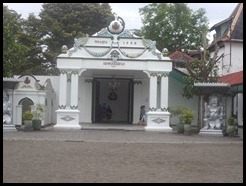 |
| The entrance to the rear palace |
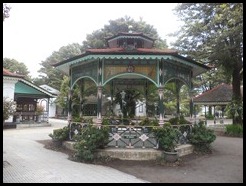 |
| Inside the palace |
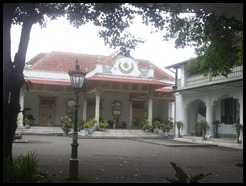 |
| Inside the palace |
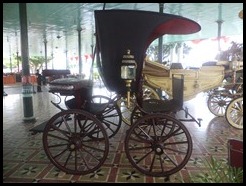 |
| An old carriage |
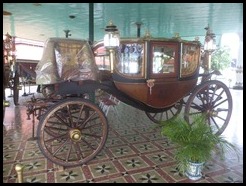 |
| An old carriage |
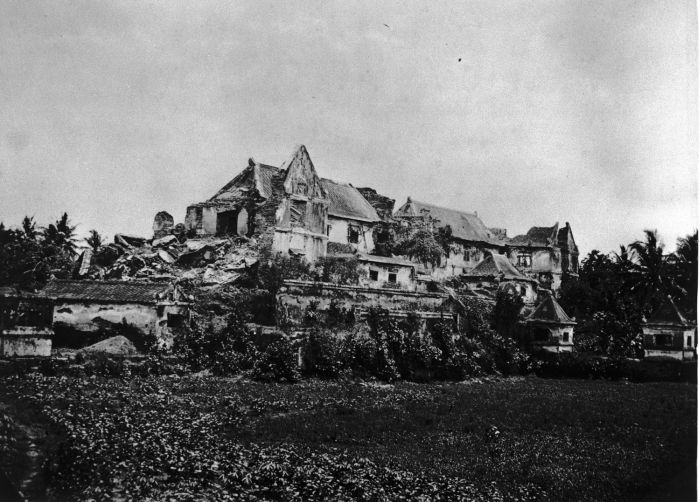 |
| An old view of the Water Castle |
 |
| A row of small Tajug buildings that functioned as air vents for the underground tunnel. The area, once an artificial lake, is now filled with settlements. |
Photographs of the underground mosque near the castle
 |
| The elevated platform where the four staircases meet |
 |
| Entrance to the pools |
 |
| The double bathing pool |
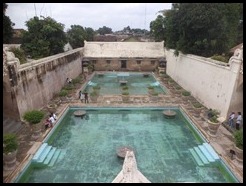 |
| What the sultan was able to see at the double bathing pool |
 |
| The single bathing pool |
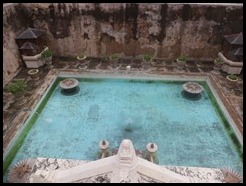 |
| The single bathing pool |
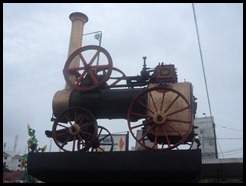 |
| A Marshall Portable Steam Boiler on a plinth near the railway station |
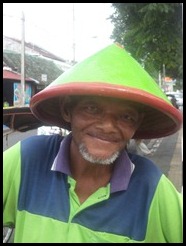 |
| Rickshaw driver |
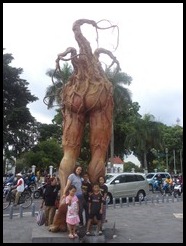 |
| Nothing to do with Indonesian culture, just a sculpture erected by the Jogyakarta Arts Society |
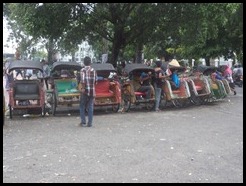 |
| Rickshaws |
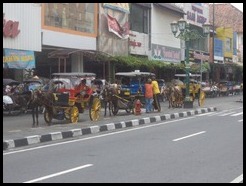 |
| Horse and buggy transport |
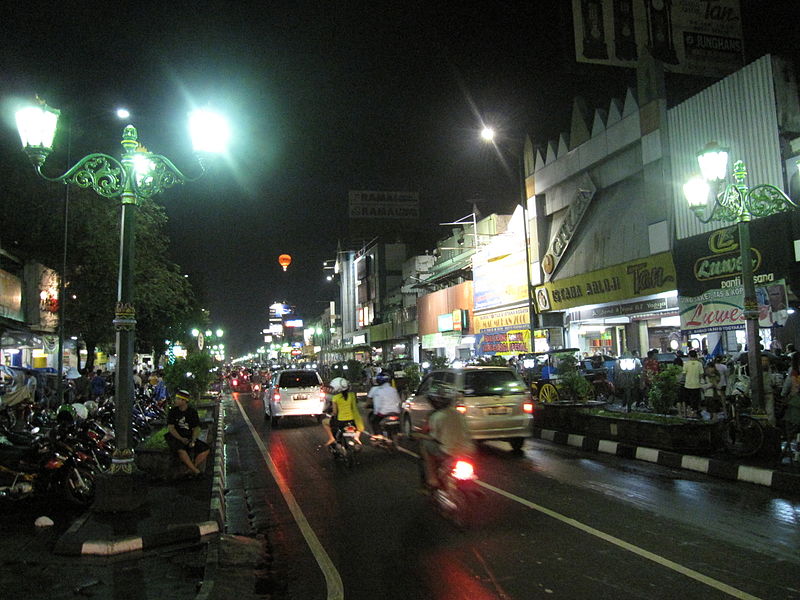 |
| Malioboro Road at night (the shopping area) On 16 January I left Jogyakarta and flew to Singapore to stay with Jane, Darren and Bronwyn. |
